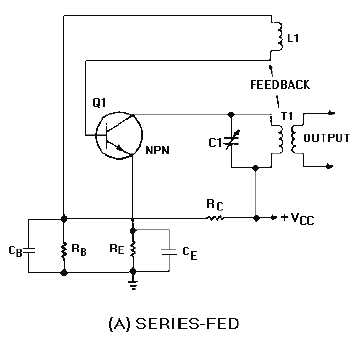2-11
advantage of the common-emitter configuration is that the medium resistance range of the input and
output simplifies the job of impedance matching.
Q-6. What type of feedback aids an input signal?
Q-7. What are the two methods used for feedback coupling?
Q-8. Which oscillator uses a tickler coil for feedback?
Q-9. Which oscillator uses a tapped inductor for feedback?
Q-10. Which oscillator uses tapped capacitors for feedback?
Q-11. What are the three basic configurations of transistor oscillators?
OSCILLATOR CIRCUITS
Oscillators may be classified by name, such as Armstrong, Hartley, Colpitts, or by the manner in
which dc power is applied. An oscillator in which dc power is supplied to the transistor through the tank
circuit, or a portion of the tank circuit, is said to be SERIES FED. An oscillator which receives its dc
power for the transistor through a path separate and parallel to the tank circuit is said to be PARALLEL
FED OR SHUNT FED. All the oscillators in this chapter can be constructed either way, series or shunt
fed. The construction depends on the characteristics of the oscillator circuit the designer is interested in.
A SERIES-FED, TUNED-COLLECTOR ARMSTRONG OSCILLATOR is illustrated in figure 2-9,
view (A). The dc path is from the negative side (ground) of VCC through RE, Q1, T1, and back to the
positive side of VCC. The figure clearly illustrates that both the ac and dc components flow through the
tank circuit.
Figure 2-9A.—Series- and shunt-fed, tuned-collector Armstrong oscillators. SERIES-FED.



